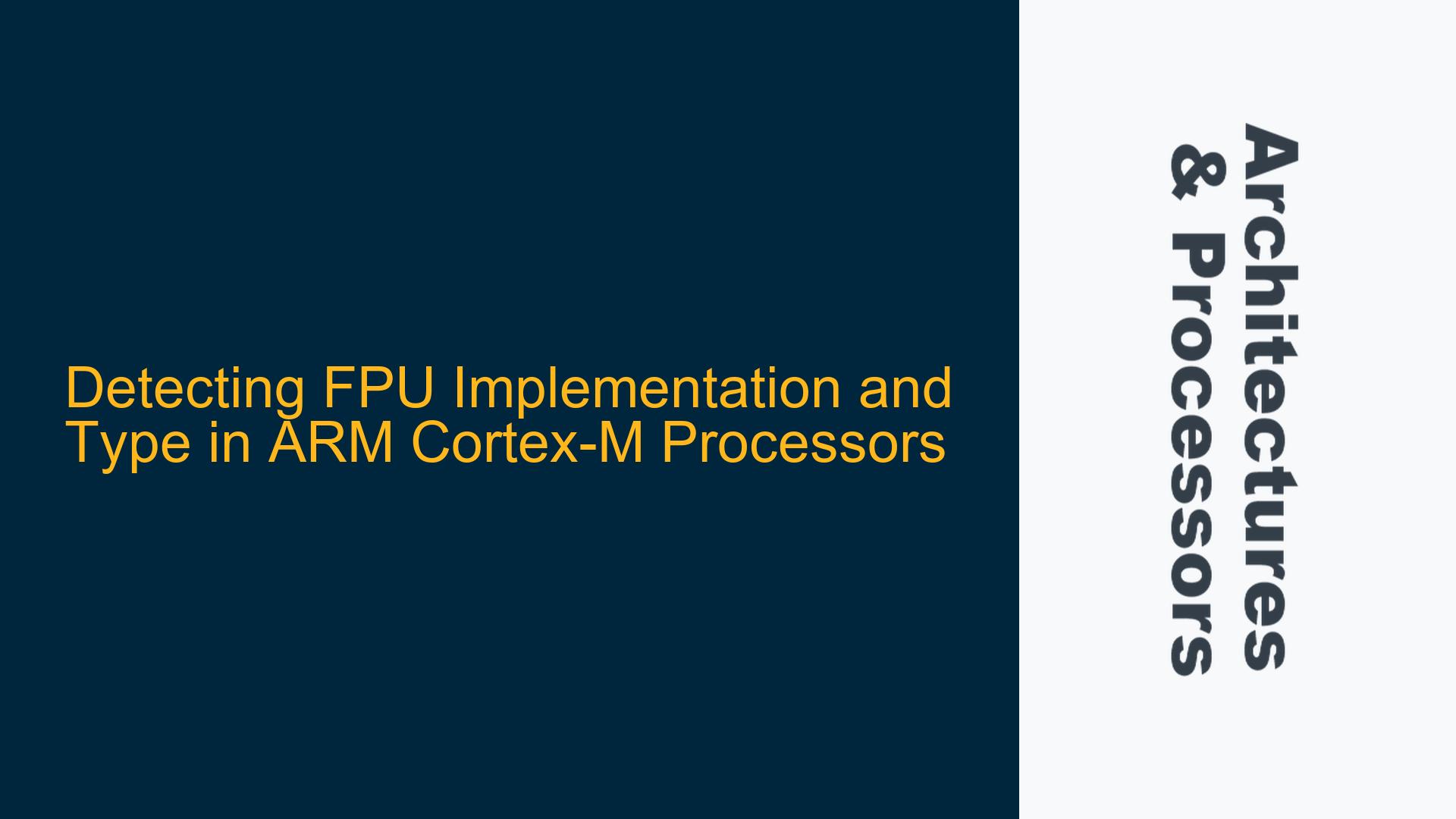ARM Cortex-M FPU Detection via Media and FP Feature Registers
The ARM Cortex-M series of processors, widely used in embedded systems, often include a Floating-Point Unit (FPU) to accelerate floating-point arithmetic operations. However, not all Cortex-M processors implement an FPU, and even among those that do, the type of FPU (e.g., VFPv4, VFPv5-SP, VFPv5-DP) can vary. Detecting the presence and type of FPU is crucial for software portability and optimization. This guide delves into the technical details of detecting FPU implementation and type using the Media and FP Feature Registers (MVFR0, MVFR1, and MVFR2) in ARM Cortex-M processors.
Media and FP Feature Registers: MVFR0, MVFR1, and MVFR2
The ARM Cortex-M architecture provides a set of registers specifically designed to convey information about the implemented features of the processor, including the FPU. These registers are known as the Media and FP Feature Registers (MVFR0, MVFR1, and MVFR2). Each of these registers contains bit fields that describe various aspects of the FPU and media processing capabilities.
The MVFR0 register, located at address 0xE000EF40, primarily provides information about the FPU’s instruction set support. The MVFR1 register, located at address 0xE000EF44, offers additional details about the FPU’s capabilities, such as the presence of single-precision or double-precision floating-point support. The MVFR2 register, located at address 0xE000EF48, is a more recent addition to the architecture and provides further details about the FPU and media processing features.
The bit fields within these registers are defined in the ARM Architecture Reference Manual, and their interpretation can vary depending on the specific Cortex-M core and its revision. For example, the MVFR0 register contains fields that indicate whether the FPU supports certain floating-point operations, such as fused multiply-add (FMA) or hardware divide and square root operations. Similarly, the MVFR1 register can indicate whether the FPU supports single-precision (SP) or double-precision (DP) floating-point operations.
Identifying FPU Type and Capabilities via MVFR Registers
To determine the type of FPU implemented in a Cortex-M processor, one must carefully examine the bit fields within the MVFR0, MVFR1, and MVFR2 registers. Each bit field corresponds to a specific feature or capability of the FPU, and the combination of these fields can be used to identify the FPU type.
For instance, the MVFR0 register’s "A_SIMD registers" field indicates whether the FPU supports Advanced SIMD (Single Instruction, Multiple Data) operations, which are typically associated with the VFPv4 or VFPv5 architectures. The "Single-precision" and "Double-precision" fields in the MVFR1 register provide information about the FPU’s support for single-precision and double-precision floating-point operations, respectively. The presence of these features can help distinguish between different FPU types, such as VFPv4-SP (single-precision only) and VFPv5-DP (double-precision support).
Additionally, the MVFR2 register, if implemented, can provide further details about the FPU’s capabilities, such as support for half-precision floating-point operations or specific media processing features. By combining the information from all three registers, one can construct a comprehensive picture of the FPU’s capabilities and determine its type.
Practical Steps for FPU Detection and Type Identification
To detect the presence of an FPU and identify its type in an ARM Cortex-M processor, follow these steps:
-
Access the MVFR0 Register: Read the value of the MVFR0 register at address 0xE000EF40. This register provides the initial information about the FPU’s instruction set support. Look for specific bit fields that indicate the presence of FPU features, such as the "A_SIMD registers" field, which is typically set to 1 if the FPU supports Advanced SIMD operations.
-
Access the MVFR1 Register: Read the value of the MVFR1 register at address 0xE000EF44. This register provides additional details about the FPU’s capabilities, such as support for single-precision or double-precision floating-point operations. The "Single-precision" and "Double-precision" fields in this register are particularly important for determining the FPU type.
-
Access the MVFR2 Register (if available): If the processor supports the MVFR2 register, read its value at address 0xE000EF48. This register provides further details about the FPU’s capabilities, such as support for half-precision floating-point operations or specific media processing features. The presence of these features can help further refine the identification of the FPU type.
-
Interpret the Bit Fields: Once the values of the MVFR0, MVFR1, and MVFR2 registers have been read, interpret the bit fields to determine the FPU’s capabilities and type. For example, if the MVFR0 register indicates support for Advanced SIMD operations and the MVFR1 register indicates support for double-precision floating-point operations, the FPU is likely a VFPv5-DP type.
-
Cross-Reference with ARM Documentation: Cross-reference the interpreted bit fields with the ARM Architecture Reference Manual to confirm the FPU type. The manual provides detailed descriptions of the bit fields and their meanings, which can help ensure accurate identification of the FPU type.
-
Implement Conditional Code: Based on the detected FPU type, implement conditional code in your software to take advantage of the available FPU features. For example, if the FPU supports double-precision floating-point operations, you can enable double-precision calculations in your software. If the FPU only supports single-precision operations, you may need to use software emulation for double-precision calculations.
-
Test and Validate: Finally, test and validate the FPU detection and type identification code on the target hardware to ensure that it works as expected. This step is crucial for verifying the accuracy of the detection process and ensuring that the software behaves correctly on different Cortex-M processors with varying FPU implementations.
By following these steps, you can reliably detect the presence of an FPU and identify its type in an ARM Cortex-M processor, enabling you to optimize your software for the specific capabilities of the target hardware.
Conclusion
Detecting the presence and type of an FPU in ARM Cortex-M processors is essential for optimizing software performance and ensuring compatibility across different hardware implementations. By leveraging the Media and FP Feature Registers (MVFR0, MVFR1, and MVFR2), developers can accurately determine the FPU’s capabilities and tailor their software accordingly. This guide has provided a detailed overview of the process, from accessing and interpreting the relevant registers to implementing conditional code based on the detected FPU type. With this knowledge, developers can confidently navigate the complexities of FPU detection and unlock the full potential of their ARM Cortex-M-based embedded systems.






